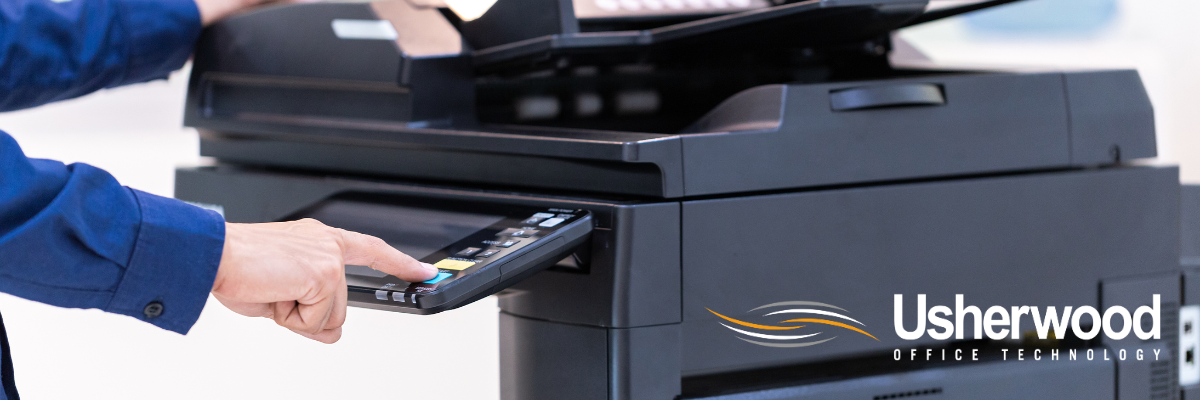By: Jada Sterling, Digital Content Manager on March 28th, 2024
Toner vs Ink Printers: What’s the Difference?
With so many variations of business printers and functions, there are just as many terms to know when purchasing one. Some factors that will determine the right device for you include:
- Materials you will print on
- Your printing budget
- Speed and volume demands
- The types of projects you’ll create
- Color vs black-and-white considerations.
When you speak to a managed print expert, they might reference two different consumables that need to be replaced in your printer: toner and ink. These may seem interchangeable, as they are both materials that create the vibrant prints you’re looking for. However, ink-based and toner-based machines both have pros and cons, and they are anything but the same.
Difference Between Ink and Toner
The main differentiating factors between ink and toner cartridges are what they consist of and how they are bound to your chosen paper or material.
Ink is liquid, and mostly found within wide-format printers, or printers designed for larger projects such as signs, posters, etc. When ink is printed onto materials, it must dry in order to “stick” or bind properly.
Toner, on the other hand, is a fine powder. This powder comes in bottles which are rotated to pull it from the tube as needed. Toner is much different than ink, as it must be heated and pressed into paper to bind. It is pressed beneath a hot roller in the machine, which you might see if you open up your toner-based printer.
Although it is rare, some printers use wax instead of ink or toner. These wide-format printers, sometimes referred to as “wax-jet” or “phase change” such as the Xerox Phaser wide-format printer, utilize a waxy polymer that is melted and bound to your medium.
Which is Cheaper, Ink or Toner?
The question of cost-effectiveness can get complicated when you consider the variations of print devices on the market. Printers could require ink, toner, or both toner and printer head replacements, or any combination which will be priced differently. The price of consumables will also vary depending on the contract between you and your managed print provider, as toner is often included while ink might not be.
In this case, ink would be an added expense. Again, ink is far less common as it is primarily used in wide-format printing. For that reason, the price you’ll pay per page will be determined by your specific device and the amount you’ll need to print.
Other Factors That Contribute to Printing Costs
A study by Gartner suggests that the initial cost of printers only makes up about 5% of their lifetime costs. However, there are expenses other than ink or toner that contribute to this metric, including maintenance, paper, and energy costs.
These vary greatly between businesses. For example, a non-profit that needs to print out brochures for a youth program will likely need to budget a lot more for printing than a law office that primarily prints black and white documents.
The non-profit would also need a printer capable of higher print volumes and faster speeds, so they wouldn’t need days to print out hundreds of copies.
How Do I Spend Less on Printer Ink?
Even if you’re able to reduce the costs of toner or ink cartridges, if your employees waste ink on abandoned print jobs, you may still be spending too much on consumables. This can be helped by using the cloud to your advantage.
Cloud printing and faxing can solve remote work inefficiencies, as well as contribute to a more secure and sustainable printing environment.
Cloud Print Management
One way to save money on consumables like ink and paper is to use a cloud application to manage your print jobs. There are many cloud printing tools on the market, and many have the capability to measure metrics such as paper use, page counts, ink usage and more. By tracking these trends, you can identify areas of improvement to reduce waste.
Cloud printing works by requiring active user intervention to retrieve print jobs. This means that in order for a print job to leave the queue and get printed, users must take additional steps. This design can help prevent abandoned documents in printer trays. This not only reduces wasted paper but lessens the risk of unauthorized individuals from getting ahold of sensitive data.
For these reasons, cloud printing solutions can be a greener and more secure option for your workplace to aid in your efforts to save on ink. To read about your options for cloud faxing, another solution for printing waste reduction, check out our blog: 8 Best Online Fax Services for Small Businesses.
Print Security Considerations
One detail you might not associate with business printing is endpoint security. Endpoints are devices connected to your business network, and they are often missing key cybersecurity protections that more valuable assets like computers come with.
According to a study by IDC, 70% of cyber attacks originate from network endpoints. Toner cartridges can pose a big risk if they aren't from a reputable source. Some toner cartridge chips are reprogrammable, meaning cyber attackers can inject them with malware. This malware can spread to your network through an infected printer, giving cybercriminals a foothold.
Because of the cybersecurity risks, you should never purchase off-brand toner cartridges. Although name-brand cartridges are often pricier, the extra cost could help prevent a devastating cyber attack against your business.
Where Can I Get Affordable Printer Ink for My Office?
Whether you need magenta, cyan or yellow toner, color ink cartridges, or black ink cartridges, it can be confusing to find and purchase the correct refills.
Many businesses partner with managed print services (MPS) that can track toner or ink levels and assist with purchasing replenishments. Print service providers can also advise you on printer and copier leasing, which might be a good option if you're not comfortable buying a printer.
How to Know the Best Time to Buy a Printer
If you are in the market to buy a multifunction printer (MFP), you should know the signs that indicate it's time for a fleet upgrade. Some key factors to know beforehand include:
- The age of your print fleet
- Your print output demands by department, on average
- Your budget and current expenses
- Data protection concerns
- Need-to-have aspects for your print environment
This is not an exhaustive list of factors to consider for print fleet optimization. To learn more about what to consider before purchasing a printer, read our blog: What to Consider Before Purchasing a Multi-Function Printer (MFP).
How to Find a Quality Managed Print Provider
A solid print environment should include secure printers, budget-friendly printing costs, and a fleet that meets necessary print volumes. In order to address these needs, it's wise to consider partnering with a managed print company to iron out a strategy.
To learn about how to find the right managed print service provider, read our blog: 7 Key Questions to Ask Your Managed Print Provider Before Partnering.
If you're ready to dive into optimizing your print environment, click the button below to speak to a print management expert about your business.
Read On

Printing in Black and White vs Color: What’s Right for You?
Looking for a new printer can be confusing. With such advanced printing technology on the market,...

Your Guide to Commercial Toner & Ink Costs for Printers
Depending on how much your business prints on a regular basis, you likely know the pain of...

5 Ways Cloud Print Management Can Save Schools Time & Money
One of the biggest reasons printing is dying out in schools is the associated costs of paper and...




